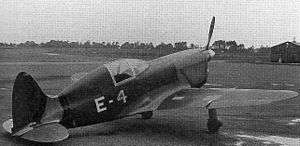de Havilland T.K.4
| T.K.4 | |
|---|---|
 | |
| Role | Single-seat racing monoplane |
| National origin | United Kingdom |
| Manufacturer | de Havilland Technical School |
| First flight | 1937 |
| Retired | 1937 |
| Status | Destroyed |
| Number built | 1 |
|
| |
The de Havilland T.K.4 was a 1930s British single-seat racing monoplane designed and built by students of the de Havilland Technical School.
Design and development
The T.K.4 was built by students at Stag Lane Aerodrome in 1937 with the aim of building the smallest possible aircraft around the 140 hp (104 kW) de Havilland Gipsy Major II.[1] It was a low-wing monoplane with a conventional retractable landing gear and had a variable-pitch propeller and was fitted with slots and flaps.[1] The only T.K.4, registered G-AETK, was first flown on 30 July 1937. It was 9th in the 1937 Kings Cup Race at a speed of 230.5 mph.[1][2] The aircraft crashed on 1 October 1937 killing the pilot R.J. Waight while he was attempting a 100 km class record.[1]
Specifications
Data from [1]
General characteristics
- Crew: 1
- Length: 15 ft 6 in (4.73 m)
- Wingspan: 19 ft 8 in (6 m)
- Empty weight: 928 lb (421 kg)
- Gross weight: 1450 lb (616 kg)
- Powerplant: 1 × de Havilland Gipsy Major II, 140 hp (104 kW)
Performance
- Maximum speed: 230 mph (369 km/h)
- Range: [2] 500 miles (311 km)
- Service ceiling: [2] 21,000 ft (6,400 m)
- Rate of climb: [2] 1,350 ft/min (6.9 m/s)
Notes
| Wikimedia Commons has media related to De Havilland T.K.4. |
References
- Jackson, A.J. (1974). British Civil Aircraft since 1919 Volume 3. London: Putnam. ISBN 0-370-10014-X.
- Lewis, Peter. "T.K. Series: Designs of the de Havilland Aeronautical Technical School". Air Pictorial. Vol. 34 No. 5 no. May 1972. pp. 187–191.